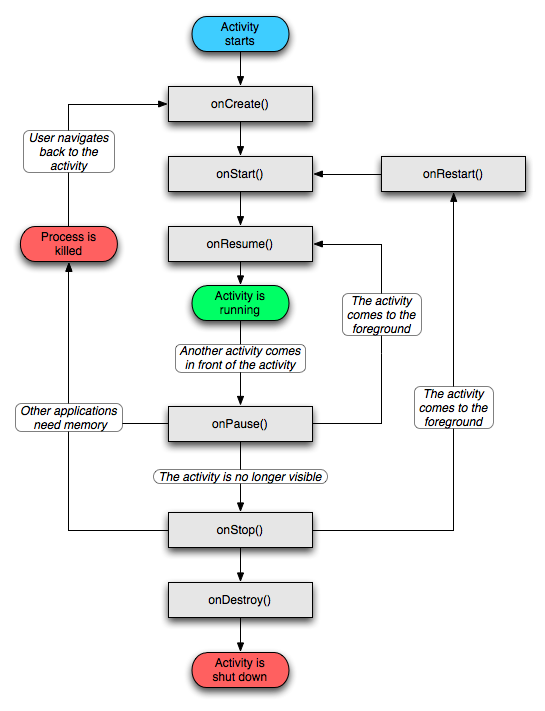本文實例分析了Android程式設計中activity的完整生命週期。分享給大家供大家參考,具體如下:
android中 activity有自己的生命週期,對這些知識的學習可以幫助我們在今後寫程式的時候,更好的理解其中遇到的一些錯誤。這篇文章很長,希望不要耽誤大家的時間~
今天不會涉及太多關於activity棧的東西,主要說activity自身的生命週期
區分幾個概念
1 Activity 官方解釋為「An Activity is an application component that provides a screen with which users can interact in order to do something, such as dial the phone, take a photo, send an email, or view a map. Each activity 你interface. 」也就是使用者用來互動的每一個窗口,使用者目前正在進行的一個操作。
2 back-stack 使用者透過觸控程式會透過application launcher來啟動一個activity A,啟動的activity A會被壓入堆疊頂,如果目前的activity A再啟動一個新的activity B,那麼此時AonStop函數,系統會維護這個activity資訊.當使用者按下back鍵的時候,back stack會進行一個pop的操作,並且呼叫A的onResume() 具體的進出棧細節,以後會詳細介紹。
3 Tasks 當用戶處於某個activi提: Activity A在名稱為"TaskOne應用ty的時候,按下HOME鍵用戶返回到launcher,此時,如果用戶再觸摸新的應用,則新建一個Task,一個back stack就代表一個task.不同程式的activity可以壓入同一個堆疊中,也就是說可以組成一個task,例如你的程式啟動了一個系統自帶的發短信的activity,給用戶的感覺就是發短信好像是你的程式中的一個功能一樣。行為,另一種是在Activity發起的intent中指定要啟動的activity設置,其中Intent的優先級要高於manifest.xml文件,並且有些mode在並不是同時都存在於兩種方式中。的生命週期包括 onCreate onStart onRestart onResume onPause onStop onDestroy ,activity在聲明週期中會呼叫以上方法來執行不同狀態對應的操作,下面介紹各個方法的呼叫時間
onCreate() when the activity is first created. This is where you should do all of your normal static set up: create views, bind data to lists, etc. This method also provides you with a Bundle containing the activity 完成者 previous .
Always followed by onStart().
//當activity第一次被創建的時候調用。等等。 has been stopped, prior to it being started again.Always followed by onStart()
//在你的activity停止後被調用,在重新開始之前調用
onResume() the activity will start interacting with the user. At this point your activity is at the top of the activity stack, with user input going to it.
Always followed by onPause().
onPause() 次狀態下activity不可被終結,android HoneyComb系統除外
Called when the system is about to startsystemis about to start resuming a previous activity. This is typically used to commit unsaved changes to persistent data, stop animations and other things that may be consuming CPU, etc. Implementations of this method must be very quick because the next activity will not be resumed until this method returns .
Followed by either onResume() if the activity returns back to the front, or onStop() if it becomes invisible to the user.
//當系統即將重新開始以前的activity的時候被調用(不懂,自己的理解是:當當前activity要啟動新的activity的時候被調用),典型的應用是用來將還未保存的數據提交到當前的數據,(意思是保存數據更新),停止animations和其他可能耗費CPU的操作。對此方法的實作必須快速因為下個activity直到此方法返回才會被重新開始。
當activity從back(翻譯後台不合適)轉到front(與使用者互動的狀態)的時候,onResume方法會在onPause方法之後被呼叫
當activity變成不可見的時候,onStop方法會在onPause之後被呼叫
onStop() 次狀態下activity可以被終結
Called when the activity is no longer visible to the user, beca hasiothers 和 has has the user, ivity has hasleum is covering this one. This may happen either because a new activity is being started, an existing one is being brought in front of this one, or this one is being destroyed.🎟 yed one, or this one is being destroyed。 interact with the user, or onDestroy() if this activity is going away.
The final cinal call you receive before your activity is destroyed. This can happen either because the activity is finishing (someone called finish() on it, or because the system is temporarily destroying this instast the or because the system is temporarily destroying this insta canying. the isFinishing() method.
好了看一下我寫的一個演示的例子吧,
<?xml version="1.0" encoding="utf-8"?>
<manifest xmlns:android="http://schemas.android.com/apk/res/android"
package="uni.activity"
android:versionCode="1"
android:versionName="1.0">
<uses-sdk android:minSdkVersion="7" />
<application android:icon="@drawable/icon" android:label="@string/app_name">
<activity android:name=".ActivityDemoActivity"
android:label="@string/app_name">
<intent-filter>
<action android:name="android.intent.action.MAIN" />
<category android:name="android.intent.category.LAUNCHER" />
</intent-filter>
</activity>
<activity android:name=".Activity01"
android:label="@string/app_name">
</activity>
</application>
</manifest><?xml version="1.0" encoding="utf-8"?> <LinearLayout xmlns:android="http://schemas.android.com/apk/res/android" android:orientation="vertical" android:layout_width="fill_parent" android:layout_height="fill_parent" > <TextView android:layout_width="fill_parent" android:layout_height="wrap_content" android:text="@string/hello" /> <Button android:id="@+id/Button_A" android:text="GO to activity 2" android:layout_width="fill_parent" android:layout_height="wrap_content" /> </LinearLayout>
<?xml version="1.0" encoding="utf-8"?> <LinearLayout xmlns:android="http://schemas.android.com/apk/res/android" android:orientation="vertical" android:layout_width="fill_parent" android:layout_height="fill_parent" > <TextView android:layout_width="fill_parent" android:layout_height="wrap_content" android:text="@string/hello" /> <Button android:id="@+id/Button_A" android:text="GO to activity 2" android:layout_width="fill_parent" android:layout_height="wrap_content" /> </LinearLayout>
<?xml version="1.0" encoding="utf-8"?> <resources> <string name="hello">Hello World, ActivityDemoActivity!</string> <string name="app_name">ActivityDemo</string> <string name="activity01">this is activity 01</string> </resources>
/*
* @author octobershiner
* 2011 07 29
* SE.HIT
* 演示完整的activity的声明周期,以及isFinish方法的调用
* 此activity为程序入口activity
* */
package uni.activity;
import android.app.Activity;
import android.content.Intent;
import android.os.Bundle;
import android.util.Log;
import android.view.View;
import android.view.View.OnClickListener;
import android.widget.Button;
public class ActivityDemoActivity extends Activity {
/** Called when the activity is first created. */
private static final String TAG = "demo";
private Button button_A;
@Override
public void onCreate(Bundle savedInstanceState) {
super.onCreate(savedInstanceState);
setContentView(R.layout.main);
button_A = (Button)this.findViewById(R.id.Button_A);
button_A.setOnClickListener(new myButtonListener());
}
private class myButtonListener implements OnClickListener{
@Override
public void onClick(View v) {
// TODO Auto-generated method stub
Intent intent = new Intent();
intent.setClass(ActivityDemoActivity.this, Activity01.class);
ActivityDemoActivity.this.startActivity(intent);
//感兴趣的朋友可以取消下面的代码注释,来测试finish方法的使用,会发现第一个activity会被强制终止
//ActivityDemoActivity.this.finish();
}
};
protected void onStart(){
super.onStart();
Log.i(TAG, "The activityDemo state---->onStart");
}
protected void onRestart(){
super.onRestart();
Log.i(TAG, "The activityDemo state---->onReatart");
}
protected void onResume(){
super.onResume();
Log.i(TAG, "The activityDemo state---->onResume");
}
protected void onPause(){
super.onPause();
//调用isFinishing方法,判断activity是否要销毁
Log.i(TAG, "The activityDemo state---->onPause");
if(isFinishing()){
Log.w(TAG, "The activityDemo will be destroyed!");
}else{
Log.w(TAG, "The activityDemo is just pausing!");
}
}
protected void onStop(){
super.onStop();
Log.i(TAG, "The activityDemo state---->onStop");
}
protected void onDestroy(){
super.onDestroy();
Log.i(TAG, "The activityDemo state---->onDestroy");
}
}/*
* @author octobershiner
* 2011 07 29
* SE.HIT
* 演示完整的activity的声明周期,以及isFinish方法的调用
* 此activity可由ActivityDemoActivity启动
* */
package uni.activity;
import android.app.Activity;
import android.os.Bundle;
import android.util.Log;
public class Activity01 extends Activity{
private static final String TAG = "demo";
@Override
protected void onCreate(Bundle savedInstanceState) {
// TODO Auto-generated method stub
super.onCreate(savedInstanceState);
setContentView(R.layout.activity01);
Log.d(TAG, "The activity01 state---->onStart");
}
protected void onStart(){
super.onStart();
Log.d(TAG, "The activity01 state---->onStart");
}
protected void onRestart(){
super.onRestart();
Log.d(TAG, "The activity01 state---->onReatart");
}
protected void onResume(){
super.onResume();
Log.d(TAG, "The activity01 state---->onResume");
}
protected void onPause(){
super.onPause();
Log.d(TAG, "The activity01 state---->onPause");
//调用isFinishing方法,判断activity是否要销毁
if(isFinishing()){
Log.w(TAG, "The activity01 will be destroyed!");
}else{
Log.w(TAG, "The activity01 is just pausing!");
}
}
protected void onStop(){
super.onStop();
Log.d(TAG, "The activity01 state---->onStop");
}
protected void onDestroy(){
super.onDestroy();
Log.d(TAG, "The activity01 state---->onDestroy");
}
}  再按返回鍵回到ActivityDemoActivity
再按返回鍵回到ActivityDemoActivity
(返回後,處於堆疊頂部的activity01會執行彈棧操作,顯示將會被destroy)
再按回傳鍵回到桌面
其實並不複雜的東邪寫的有些長了,但是基本上的顯示了activity的完整的生命週期。
希望本文所述對大家Android程式設計有幫助。
更多android橫豎屏切換時候Activity的生命週期相關文章請關注PHP中文網!




